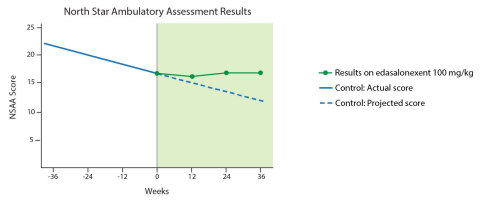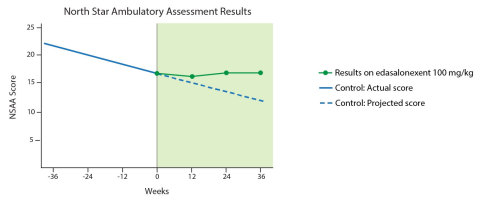CAMBRIDGE, Mass.--(BUSINESS WIRE)--Catabasis Pharmaceuticals, Inc. (NASDAQ:CATB), a clinical-stage biopharmaceutical company, today reported new positive efficacy results showing sustained disease-modifying effects in the MoveDMD trial open-label extension following 24 and 36 weeks of treatment with edasalonexent. Across all key assessments of muscle function, improvements were observed in the rate of decline after 24 and 36 weeks of oral 100 mg/kg/day edasalonexent treatment compared to the rate of change in the control period for boys prior to receiving edasalonexent treatment. These data provide clinically meaningful evidence that edasalonexent substantially slowed the progression of Duchenne muscular dystrophy (DMD).
Additionally, supportive changes in measures of muscle health were seen, consistent with positive edasalonexent treatment effects. Muscle enzymes significantly decreased compared to baseline at 12 weeks and later time points (p<0.05) and lower leg muscle MRI T2 rate of change was significantly improved in comparison to progression during the control period (p≤0.05). Edasalonexent continued to be well tolerated with no safety signals observed in the trial.
Based on the consistency of the MoveDMD results and supportive regulatory input from FDA, Catabasis plans to initiate a single global Phase 3 trial with edasalonexent in patients with DMD regardless of mutation type in the first half of 2018 with top-line results expected in 2020. The data were presented today in a late breaking session at the World Muscle Society Conference and will be discussed, along with the Phase 3 clinical trial plan, on a conference call today, October 4, 2017.
“We are extremely excited to see edasalonexent change the trajectory of disease in the MoveDMD trial with substantially slowed disease progression,” said Jill C. Milne, Ph.D., Chief Executive Officer of Catabasis. “Boys treated with edasalonexent stabilized; they experienced meaningful improvements in muscle function compared to the rates of change observed during the control period. Importantly, other supportive positive measures of muscle health were observed. We look forward to advancing edasalonexent as a disease-modifying therapy in a single Phase 3 pivotal trial as soon as possible with the goal of providing a meaningful impact on disease progression for all boys affected by Duchenne.”
“Our goal in treating boys with Duchenne is to slow the progression of the disease. It is tremendously encouraging to see boys taking edasalonexent stabilize in their functional abilities and MRI T2 measures along with its continued safety profile,” said Richard Finkel, M.D., Chief, Division of Neurology, Department of Pediatrics at Nemours Children’s Health System and a Principal Investigator for the study. “I look forward to continuing to investigate edasalonexent as a potential therapy for the many boys affected by this devastating disease.”
In the MoveDMD trial, a substantial slowing of the disease progression of DMD was seen in boys treated with edasalonexent compared to the rates of change during the control period. Through 36 weeks of treatment, the 100 mg/kg/day treatment group showed clinically meaningful numerical improvements in rates of decline compared to rates of change during the control period across all three timed function tests (10-meter walk/run, 4-stair climb and time to stand), as well as the North Star Ambulatory Assessment (NSAA), an integrated global assessment of muscle function. Control period changes were measured prior to boys receiving edasalonexent, either prior to Phase 2 or in the placebo group, for time periods averaging 39 weeks. In the 100 mg/kg/day treatment group, 16 boys commenced edasalonexent either at the beginning of Phase 2 or at the beginning of the open-label extension. At the time of the open-label extension data analysis, all 14 boys continuing to participate had received 100 mg/kg/day for 24 weeks and 11 had completed 36 weeks of 100 mg/kg/day edasalonexent treatment. Results are detailed for the 100 mg/kg/day treatment group as all boys are now taking this dose in the open-label extension.
Additional supportive measures of muscle health were also consistent with a positive edasalonexent treatment effect. Four muscle enzymes (creatine kinase, alanine aminotransferase, aspartate aminotransferase and lactate dehydrogenase) were significantly decreased compared to baseline following edasalonexent treatment at 12 weeks and later time points (p<0.05), consistent with the ability to slow muscle degeneration and improve muscle integrity. Rate of change in lower leg MRI T2 significantly improved at 12 weeks and at last observation on treatment compared to control period (p≤0.05), consistent with a reduction of inflammation in the muscle.
Edasalonexent continued to be well tolerated with no safety signals observed to date in the MoveDMD trial. The majority of adverse events (AEs) have been mild in nature with no serious AEs. There have been no dose reductions and no drug-related discontinuations. The most common AEs were gastrointestinal, primarily mild and transient diarrhea. Height, weight and BMI growth patterns were similar to standard growth curves for unaffected boys in the age range of MoveDMD subjects. Boys with DMD in this age range typically have resting tachycardia, a heart rate that exceeds the normal resting rate, and heart rate of the boys treated with edasalonexent decreased toward age-normative values during treatment. We believe these clinical heart rate observations are intriguing and warrant follow-up.
Catabasis plans to commence a single global Phase 3 trial in DMD in the first half of 2018 to evaluate the efficacy and safety of edasalonexent for registration purposes. The planned design of the randomized, double-blind, placebo-controlled trial is informed by discussions with FDA. Catabasis plans for the Phase 3 trial to have many elements in common with the Phase 2 trial including the patient population and endpoints. The trial is anticipated to enroll approximately 125 patients ages 4 to 7 who have not been on steroids for at least 6 months. The primary efficacy endpoint will be change in the North Star Ambulatory Assessment score after 12 months of treatment with edasalonexent compared to placebo. Key secondary endpoints are planned to include age-appropriate timed function tests. Catabasis expects to report top-line results from this trial in 2020.
“We are excited to see positive effects on muscle function with edasalonexent, as we know from research that effects on muscle function are the most important aspect of a therapy for Duchenne for the affected patients and their families,” said Pat Furlong, Founding President and Chief Executive Officer of Parent Project Muscular Dystrophy (PPMD). “We look forward to learning more about edasalonexent as Catabasis begins its Phase 3 trial. With the disease-modifying effects and safety and tolerability profile observed to date for edasalonexent, it has the potential to be a foundational therapy for all people affected by Duchenne.”
Conference Call and Webcast
Catabasis will host a conference call and webcast today, October 4, 2017, at 8:30am ET to discuss the open-label extension results from the MoveDMD trial and the Phase 3 clinical trial plan for edasalonexent.
Participant Toll-Free Dial-In Number: (877) 388-2733
Participant International Dial-In Number: (541) 797-2984
Pass Code: 90435261
Please specify to the operator that you would like to join the “Catabasis MoveDMD Results Call.”
Interested parties may access a live audio webcast of the conference call via the investor section of the Catabasis website, www.catabasis.com. Please connect to the Catabasis website several minutes prior to the start of the broadcast to ensure adequate time for any software download that may be necessary. The webcast will be archived for 90 days.
About the MoveDMD Phase 2 Trial
The MoveDMD trial included a randomized, double-blind, placebo-controlled Phase 2 trial with 31 ambulatory boys enrolled between ages 4 and 7 years with a genetically confirmed diagnosis of DMD across a range of dystrophin mutations. The boys were all steroid naive. The open-label extension was initiated in July 2016 and is evaluating longer term safety and efficacy with the same clinical endpoints as the placebo-controlled portion. Based on Phase 2 results, all boys who were on the lower dose (67 mg/kg/day) were transitioned to the higher dose (100 mg/kg/day) because a greater treatment effect was observed with the higher dose, consistent with a dose response. Catabasis expects to submit additional data for presentation to scientific meetings in 2018.
About Edasalonexent (CAT-1004)
Edasalonexent (CAT-1004) is an investigational oral small molecule that is being developed as a potential disease-modifying therapy for all patients affected by DMD, regardless of their underlying mutation. Edasalonexent inhibits NF-kB, a protein that is activated in DMD and drives inflammation and fibrosis, muscle degeneration and suppresses muscle regeneration. We are currently conducting the MoveDMD trial, a three-part clinical trial investigating the safety and efficacy of edasalonexent in boys enrolled at ages 4 – 7 affected with DMD (any confirmed mutation). The third part of the trial, an open-label extension with edasalonexent, is ongoing. The FDA has granted orphan drug, fast track and rare pediatric disease designations and the European Commission has granted orphan medicinal product designation to edasalonexent for the treatment of DMD. For a summary of clinical results reported to-date, please visit www.catabasis.com.
About Catabasis
At Catabasis Pharmaceuticals, our mission is to bring hope and life-changing therapies to patients and their families. Our SMART (Safely Metabolized And Rationally Targeted) Linker drug discovery platform enables us to engineer molecules that simultaneously modulate multiple targets in a disease. We are applying our SMART LinkerSM platform to build an internal pipeline of product candidates for rare diseases and plan to pursue partnerships to develop additional product candidates. For more information on the Company's drug discovery platform and pipeline of drug candidates, please visit www.catabasis.com.
Forward Looking Statements
Any statements in this press release about future expectations, plans and prospects for the Company, including statements about future clinical trial plans including, among other things, statements about our plans to commence a single global Phase 3 trial in DMD in the first half of 2018 to evaluate the efficacy and safety of edasalonexent for registration purposes, our plans to report top-line results from this trial in 2020 and our plans to continue to evaluate data from the open-label extension of our MoveDMD® clinical trial of edasalonexent for the treatment of DMD, and other statements containing the words “believes,” “anticipates,” “plans,” “expects,” “may” and similar expressions, constitute forward-looking statements within the meaning of the Private Securities Litigation Reform Act of 1995. Actual results may differ materially from those indicated by such forward-looking statements as a result of various important factors, including: uncertainties inherent in the initiation and completion of preclinical studies and clinical trials and clinical development of the Company’s product candidates, including the final trial design of our planned Phase 3 trial in DMD; availability and timing of results from preclinical studies and clinical trials, including the availability of top-line results from our planned Phase 3 trial in DMD in 2020; whether interim results from a clinical trial will be predictive of the final results of the trial or the results of future trials; expectations for regulatory approvals to conduct trials or to market products; our ability to obtain financing on acceptable terms and in a timely manner to fund our planned Phase 3 trial in DMD to evaluate the efficacy and safety of edasalonexent for registration purposes; availability of funding sufficient for the Company’s foreseeable and unforeseeable operating expenses and capital expenditure requirements; other matters that could affect the availability or commercial potential of the Company’s product candidates; and general economic and market conditions and other factors discussed in the “Risk Factors” section of the Company’s Quarterly Report on Form 10-Q for the period ended June 30, 2017, which is on file with the Securities and Exchange Commission, and in other filings that the Company may make with the Securities and Exchange Commission in the future. In addition, the forward-looking statements included in this press release represent the Company’s views as of the date of this press release. The Company anticipates that subsequent events and developments will cause the Company’s views to change. However, while the Company may elect to update these forward-looking statements at some point in the future, the Company specifically disclaims any obligation to do so. These forward-looking statements should not be relied upon as representing the Company’s views as of any date subsequent to the date of this release.




